A Systematic Literature Review of Maritime Transportation Safety Management
Abstract
:1. Introduction
2. Data Source and Bibliometric Methods
2.1. Data Source
2.2. Bibliometric Methods
3. Descriptive Statistical Analysis
3.1. Publication and Citation Distribution Analysis
3.2. Country and Institution Distribution Analysis
3.3. Influential Journal and Study Analysis
3.3.1. Influential Journal Analysis
3.3.2. Influential Scholar Analysis
3.3.3. Highly Cited Articles
4. Network-Based Bibliometric Analysis
4.1. Keyword Analysis
4.2. Co-Cited Analysis
4.2.1. Journal Co-Citations
4.2.2. Article Co-Citations
4.2.3. Author Co-Citations
5. Methodology for Maritime Safety and Emergency Management
5.1. Overview of the Research Methods
5.2. The Progressive Trend of Research Methods
5.3. Spatial Interaction Visualization of Research Methods
6. Discussion and Future Research
6.1. Quantitative and Systematic Assessment of Maritime Transportation System Resilience
6.2. Data- or Intelligence-Driven Technologies for Maritime Safety and Emergency Management
6.3. Scenario Representation and Digital Twins Are Becoming Critical and Practical for Maritime Emergency Research
6.4. Issues Associated with Intelligent Maritime Shipping Require Urgent Attention for a Sustainable Maritime Industry
7. Conclusions
Author Contributions
Funding
Institutional Review Board Statement
Informed Consent Statement
Data Availability Statement
Conflicts of Interest
References
- UNCTAD. Review of Maritime Transport 2022. 2022. Available online: https://unctad.org/system/files/official-document/rmt2022_en.pdf (accessed on 18 October 2023).
- Arici, S.S.; Akyuz, E.; Arslan, O. S Application of fuzzy bow-tie risk analysis to maritime transportation: The case of ship collision during the STS operation. Ocean Eng. 2020, 217, 107960. [Google Scholar] [CrossRef]
- Størkersen, K.V.; Antonsen, S.; Kongsvik, T. One size fits all? Safety management regulation of ship accidents and personal injuries. J. Risk Res. 2017, 20, 1154–1172. [Google Scholar] [CrossRef]
- Yoo, Y.; Park, H.S. Qualitative risk assessment of cybersecurity and development of vulnerability enhancement plans in consideration of digitalized ship. J. Mar. Sci. Eng. 2021, 9, 565. [Google Scholar] [CrossRef]
- Zhang, L.; Wang, H.; Meng, Q.; Xie, H. Ship accident consequences and contributing factors analyses using ship accident investigation reports. Proc. Inst. Mech. Eng. Part O-J. Risk Reliab. 2019, 233, 35–47. [Google Scholar] [CrossRef]
- MOT. Statistical Bulletin on the Development of Transportation Industry; Ministry of Transport of China: Beijing, China, 2019. [Google Scholar]
- EMSA. Annual Overview of Marine Casualties and Incidents; European Maritime Safety Agency: Lisbon, Portugal, 2019. [Google Scholar]
- Ramos, K.G.; Rocha, I.C.N.; Cedeno, T.D.D.; Dos Santos Costa, A.C.; Ahmad, S.; Essar, M.Y.; Tsagkaris, C. Suez Canal blockage and its global impact on healthcare amidst the COVID-19 pandemic. Int. Marit. Health 2021, 72, 145–146. [Google Scholar] [CrossRef] [PubMed]
- Celik, M.; Cebi, S. Analytical HFACS for investigating human errors in shipping accidents. Accid. Anal. Prev. 2009, 41, 66–75. [Google Scholar] [CrossRef] [PubMed]
- Baalisampang, T.; Abbassi, R.; Garaniya, V.; Khan, F.; Dadashzadeh, M. Review and analysis of fire and explosion accidents in maritime transportation. Ocean Eng. 2018, 158, 350–366. [Google Scholar] [CrossRef]
- Goerlandt, F.; Montewka, J. Maritime transportation risk analysis: Review and analysis in light of some foundational issues. Reliab. Eng. Syst. Saf. 2015, 138, 115–134. [Google Scholar] [CrossRef]
- Huang, X.; Wen, Y.; Zhang, F.; Han, H.; Huang, Y.; Sui, Z. A review on risk assessment methods for maritime transport. Ocean Eng. 2023, 279, 114577. [Google Scholar] [CrossRef]
- Kandemir, C.; Celik, M. A systematic literature review and future insights on maritime and offshore human reliability analysis. Proc. Inst. Mech. Eng. Part M J. Eng. Marit. Environ. 2023, 237, 3–19. [Google Scholar] [CrossRef]
- Lim, G.J.; Cho, J.; Bora, S.; Biobaku, T.; Parsaei, H. Models and computational algorithms for maritime risk analysis: A review. Ann. Oper. Res. 2018, 271, 765–786. [Google Scholar] [CrossRef]
- Moreno, F.C.; Gonzalez, J.R.; Muro, J.S.; Maza, J.G. Relationship between human factors and a safe performance of vessel traffic service operators: A systematic qualitative-based review in maritime safety. Saf. Sci. 2022, 155, 105892. [Google Scholar] [CrossRef]
- Ozbas, B. Safety Risk Analysis of Maritime Transportation Review of the Literature. Transp. Res. Rec. 2013, 2326, 32–38. [Google Scholar] [CrossRef]
- Talley, W.K. Maritime transportation research: Topics and methodologies. Marit. Policy Manag. 2013, 40, 709–725. [Google Scholar] [CrossRef]
- Wu, B.; Yip, T.L.; Yan, X.; Guedes Soares, C. Review of techniques and challenges of human and organizational factors analysis in maritime transportation. Reliab. Eng. Syst. Saf. 2022, 219, 108249. [Google Scholar] [CrossRef]
- Zhang, G.; Thai, V.V. Expert elicitation and Bayesian Network modeling for shipping accidents: A literature review. Saf. Sci. 2016, 87, 53–62. [Google Scholar] [CrossRef]
- Li, S.; Meng, Q.; Qu, X. An overview of maritime waterway quantitative risk assessment models. Risk Anal. 2012, 32, 496–512. [Google Scholar] [CrossRef] [PubMed]
- Suárez-Alemán, A. Short sea shipping in today’s Europe: A critical review of maritime transport policy. Marit. Econ. Logist. 2016, 18, 331–351. [Google Scholar] [CrossRef]
- Al-Enazi, A.; Okonkwo, E.C.; Bicer, Y.; Al-Ansari, T. A review of cleaner alternative fuels for maritime transportation. Energy Rep. 2021, 7, 1962–1985. [Google Scholar] [CrossRef]
- Laera, F.; Fiorentino, M.; Evangelista, A.; Boccaccio, A.; Manghisi, V.M.; Gabbard, J.; Gattullo, M.; Uva, A.E.; Foglia, M.M. Augmented reality for maritime navigation data visualisation: A systematic review, issues and perspectives. J. Navig. 2021, 74, 1073–1090. [Google Scholar] [CrossRef]
- Larsen, M.H.; Lund, M.S. Cyber risk perception in the maritime domain: A systematic literature review. IEEE Access 2021, 9, 144895–144905. [Google Scholar] [CrossRef]
- Gu, B.; Liu, J. A systematic review of resilience in the maritime transport. Int. J. Logist. Res. Appl. 2023, 1–22. [Google Scholar] [CrossRef]
- Wallin, J.A. Bibliometric methods: Pitfalls and possibilities. Basic Clin. Pharmacol. Toxicol. 2005, 97, 261–275. [Google Scholar] [CrossRef] [PubMed]
- Gutierrez-Salcedo, M.; Angeles Martinez, M.; Moral-Munoz, J.A.; Herrera-Viedma, E.; Cobo, M.J. Some bibliometric procedures for analyzing and evaluating research fields. Appl. Intell. 2018, 48, 1275–1287. [Google Scholar] [CrossRef]
- Gil, M.; Wróbel, K.; Montewka, J.; Goerlandt, F. A bibliometric analysis and systematic review of shipboard Decision Support Systems for accident prevention. Saf. Sci. 2020, 128, 104717. [Google Scholar] [CrossRef]
- Donthu, N.; Kumar, S.; Mukherjee, D.; Pandey, N.; Lim, W.M. How to conduct a bibliometric analysis: An overview and guidelines. Bus. Res. 2021, 133, 285–296. [Google Scholar] [CrossRef]
- Liang, Y.; Li, Y.; Zhao, J.; Wang, X.; Zhu, H.; Chen, X. Study of acupuncture for low back pain in recent 20 years: A bibliometric analysis via CiteSpace. J. Pain Res. 2017, 2017, 951–964. [Google Scholar] [CrossRef]
- Wei, J.; Liang, G.; Alex, J.; Zhang, T.; Ma, C. Research progress of energy utilization of agricultural waste in China: Bibliometric analysis by citespace. Sustainability 2020, 12, 812. [Google Scholar] [CrossRef]
- Kumar, S.; Sureka, R.; Lim, W.M.; Kumar Mangla, S.; Goyal, N. What do we know about business strategy and environmental research? Insights from Business Strategy and the Environment. Bus. Strategy Environ. 2021, 30, 3454–3469. [Google Scholar] [CrossRef]
- Hu, H.; Xue, W.; Jiang, P.; Li, Y. Bibliometric analysis for ocean renewable energy: An comprehensive review for hotspots, frontiers, and emerging trends. Renew. Sustain. Energy Rev. 2022, 167, 112739. [Google Scholar] [CrossRef]
- Wu, M.; Jiang, Y.; Kwong, R.W.; Brar, S.K.; Zhong, H.; Ji, R. How do humans recognize and face challenges of microplastic pollution in marine environments? A bibliometric analysis. Environ. Pollut. 2021, 280, 116959. [Google Scholar] [CrossRef] [PubMed]
- Chang, C.C.; Chen, S.Y.; Yu, S.C. Security management in maritime supply chain—The case of liner shipping companies. In Proceedings of the 1st International Symposium on Technology Innovation, Risk Management and Supply Chain Management, Beijing, China, 1–3 November 2007; pp. 76–85. [Google Scholar]
- Zhou, X. A comprehensive framework for assessing navigation risk and deploying maritime emergency resources in the South China Sea. Ocean Eng. 2022, 248, 110797. [Google Scholar] [CrossRef]
- Jiang, M.; Lu, J.; Qu, Z.; Yang, Z. Port vulnerability assessment from a supply Chain perspective. Ocean Coast. Manag. 2021, 213, 105851. [Google Scholar] [CrossRef]
- Akyuz, E.; Celik, E. A quantitative risk analysis by using interval type-2 fuzzy FMEA approach: The case of oil spill. Marit. Policy Manag. 2018, 45, 979–994. [Google Scholar] [CrossRef]
- Li, X.; Tang, W. Structural risk analysis model of damaged membrane LNG carriers after grounding based on Bayesian belief networks. Ocean Eng. 2019, 171, 332–344. [Google Scholar] [CrossRef]
- Wen, T.; Gao, Q.; Chen, Y.; Cheong, K.H. Exploring the vulnerability of transportation networks by entropy: A case study of Asia-Europe maritime transportation network. Reliab. Eng. Syst. Saf. 2022, 226, 108578. [Google Scholar] [CrossRef]
- Wu, B.; Zhao, C.; Yip, T.L.; Jiang, D. A novel emergency decision-making model for collision accidents in the Yangtze River. Ocean Eng. 2021, 223, 108622. [Google Scholar] [CrossRef]
- Chen, S.T.; Wall, A.; Davies, P.; Yang, Z.; Wang, J.; Chou, Y.-H. A Human and Organisational Factors (HOFs) analysis method for marine casualties using HFACS-Maritime Accidents (HFACS-MA). Saf. Sci. 2013, 60, 105–114. [Google Scholar] [CrossRef]
- Fan, S.; Yang, Z.; Blanco-Davis, E.; Zhang, J.; Yan, X. Analysis of maritime transport accidents using Bayesian networks. Proc. Inst. Mech. Eng. Part O-J. Risk Reliab. 2020, 234, 439–454. [Google Scholar] [CrossRef]
- Jiang, M.; Lu, J. Maritime accident risk estimation for sea lanes based on a dynamic Bayesian network. Marit. Policy Manag. 2020, 47, 649–664. [Google Scholar] [CrossRef]
- Liu, H.; Tian, Z.; Huang, A.; Yang, Z. Analysis of vulnerabilities in maritime supply chains. Reliab. Eng. Syst. Saf. 2018, 169, 475–484. [Google Scholar] [CrossRef]
- Zhang, M.; Zhang, D.; Yao, H.; Zhang, K. A probabilistic model of human error assessment for autonomous cargo ships focusing on human-autonomy collaboration. Saf. Sci. 2020, 130, 104838. [Google Scholar] [CrossRef]
- Zhang, L.; Lu, J.; Yang, Z. Optimal scheduling of emergency resources for major maritime oil spills considering time-varying demand and transportation networks. Eur. J. Oper. Res. 2021, 293, 529–546. [Google Scholar] [CrossRef]
- Jiang, M.; Wang, B.; Hao, Y.; Chen, S.; Lu, J. Vulnerability assessment of strait/canals in maritime transportation using fuzzy evidential reasoning approach. Risk Anal. 2022, 43, 1795–1810. [Google Scholar] [CrossRef] [PubMed]
- Wan, C.; Tao, J.; Yang, Z.; Zhang, D. Evaluating recovery strategies for the disruptions in liner shipping networks: A resilience approach. Int. J. Logist. Manag. 2022, 33, 389–409. [Google Scholar] [CrossRef]
- Wrobel, K.; Montewka, J.; Kujala, P. Towards the assessment of potential impact of unmanned vessels on maritime transportation safety. Reliab. Eng. Syst. Saf. 2017, 165, 155–169. [Google Scholar] [CrossRef]
- Baksh, A.A.; Abbassi, R.; Garaniya, V.; Khan, F. Marine transportation risk assessment using Bayesian Network: Application to Arctic waters. Ocean Eng. 2018, 159, 422–436. [Google Scholar] [CrossRef]
- Mansouri, S.A.; Lee, H.; Aluko, O. Multi-objective decision support to enhance environmental sustainability in maritime shipping: A review and future directions. Transp. Res. Part E-Logist. Transp. Rev. 2015, 78, 3–18. [Google Scholar] [CrossRef]
- Wan, C.; Yan, X.; Zhang, D.; Qu, Z.; Yang, Z. An advanced fuzzy Bayesian-based FMEA approach for assessing maritime supply chain risks. Transp. Res. Part E-Logist. Transp. Rev. 2019, 125, 222–240. [Google Scholar] [CrossRef]
- Notteboom, T.; Pallis, T.; Rodrigue, J.P. Disruptions and resilience in global container shipping and ports: The COVID-19 pandemic versus the 2008–2009 financial crisis. Marit. Econ. Logist. 2021, 23, 179–210. [Google Scholar] [CrossRef]
- Lam, J.S.L.; Bai, X. A quality function deployment approach to improve maritime supply chain resilience. Transp. Res. Part E-Logist. Transp. Rev. 2016, 92, 16–27. [Google Scholar] [CrossRef]
- Zhang, J.; Teixeira, A.P.; Guedes Soares, C.; Yan, X.; Liu, K. Maritime Transportation Risk Assessment of Tianjin Port with Bayesian Belief Networks. Risk Anal. 2016, 36, 1171–1187. [Google Scholar] [CrossRef] [PubMed]
- Akyuz, E. A marine accident analysing model to evaluate potential operational causes in cargo ships. Saf. Sci. 2017, 92, 17–25. [Google Scholar] [CrossRef]
- Van Eck, N.J.; Waltman, L.; Noyons, E.C.M.; Buter, R.K. Automatic term identification for bibliometric mapping. Scientometrics 2010, 82, 581–596. [Google Scholar] [CrossRef]
- Van Eck, N.J.; Waltman, L. Software survey: VOSviewer, a computer program for bibliometric mapping. Scientometrics 2010, 84, 523–538. [Google Scholar] [CrossRef] [PubMed]
- Fu, S.; Zhang, D.; Montewka, J.; Yan, X.; Zio, E. Towards a probabilistic model for predicting ship besetting in ice in Arctic waters. Reliab. Eng. Syst. Saf. 2016, 155, 124–136. [Google Scholar] [CrossRef]
- Kujala, P.; Hanninen, M.; Arola, T.; Ylitalo, J. Analysis of the marine traffic safety in the Gulf of Finland. Reliab. Eng. Syst. Saf. 2009, 94, 1349–1357. [Google Scholar] [CrossRef]
- Kum, S.; Sahin, B. A root cause analysis for Arctic Marine accidents from 1993 to 2011. Saf. Sci. 2015, 74, 206–220. [Google Scholar] [CrossRef]
- Goerlandt, F.; Montewka, J. A framework for risk analysis of maritime transportation systems: A case study for oil spill from tankers in a ship-ship collision. Saf. Sci. 2015, 76, 42–66. [Google Scholar] [CrossRef]
- Montewka, J.; Ehlers, S.; Goerlandt, F.; Hinz, T.; Tabri, K.; Kujala, P. A framework for risk assessment for maritime transportation systems-A case study for open sea collisions involving RoPax vessels. Reliab. Eng. Syst. Saf. 2014, 124, 142–157. [Google Scholar] [CrossRef]
- Zhang, D.; Yan, X.P.; Yang, Z.L.; Wall, A.; Wang, J. Incorporation of formal safety assessment and Bayesian network in navigational risk estimation of the Yangtze River. Reliab. Eng. Syst. Saf. 2013, 118, 93–105. [Google Scholar] [CrossRef]
- Akhtar, M.J.; Utne, I.B. Human fatigue’s effect on the risk of maritime groundings—A Bayesian Network modeling approach. Saf. Sci. 2014, 62, 427–440. [Google Scholar] [CrossRef]
- Chauvin, C.; Lardjane, S.; Morel, G.; Clostermann, J.P.; Langard, B. Human and organisational factors in maritime accidents: Analysis of collisions at sea using the HFACS. Accid. Anal. Prev. 2013, 59, 26–37. [Google Scholar] [CrossRef] [PubMed]
- Trucco, P.; Cagno, E.; Ruggeri, F.; Grande, O. A Bayesian Belief Network modelling of organisational factors in risk analysis: A case study in maritime transportation. Reliab. Eng. Syst. Saf. 2008, 93, 845–856. [Google Scholar] [CrossRef]
- Yang, Z.L.; Wang, J.; Bonsall, S.; Fang, Q.G. Use of Fuzzy Evidential Reasoning in Maritime Security Assessment. Risk Anal. 2009, 29, 95–120. [Google Scholar] [CrossRef] [PubMed]
- Calatayud, A.; Mangan, J.; Palacin, R. Vulnerability of international freight flows to shipping network disruptions: A multiplex network perspective. Transp. Res. Part E Logist. Transp. Rev. 2017, 108, 195–208. [Google Scholar] [CrossRef]
- Akyuz, E.; Celik, M. Utilisation of cognitive map in modelling human error in marine accident analysis and prevention. Saf. Sci. 2014, 70, 19–28. [Google Scholar] [CrossRef]
- Akyuz, E.; Celik, M. A hybrid human error probability determination approach: The case of cargo loading operation in oil/chemical tanker ship. J. Loss Prev. Process Ind. 2016, 43, 424–431. [Google Scholar] [CrossRef]
- Franca, J.E.M.; Hollnagel, E.; dos Santos, I.J.A.L.; Haddad, A.N. FRAM AHP approach to analyse offshore oil well drilling and construction focused on human factors. Cogn. Technol. Work. 2020, 22, 653–665. [Google Scholar] [CrossRef]
- Fu, S.; Yu, Y.; Chen, J.; Xi, Y.; Zhang, M. A framework for quantitative analysis of the causation of grounding accidents in arctic shipping. Reliab. Eng. Syst. Saf. 2022, 226, 108706. [Google Scholar] [CrossRef]
- Fu, S.; Yan, X.; Zhang, D.; Zhang, M. Risk influencing factors analysis of Arctic maritime transportation systems: A Chinese perspective. Marit. Policy Manag. 2018, 45, 439–455. [Google Scholar] [CrossRef]
- Khan, B.; Khan, F.; Veitch, B. A Dynamic Bayesian Network model for ship-ice collision risk in the Arctic waters. Saf. Sci. 2020, 130, 104858. [Google Scholar] [CrossRef]
- Khan, B.; Khan, F.; Veitch, B.; Yang, M. An operational risk analysis tool to analyze marine transportation in Arctic waters. Reliab. Eng. Syst. Saf. 2018, 169, 485–502. [Google Scholar] [CrossRef]
- Khan, B.; Khan, F.; Veitch, B. A cellular automation model for convoy traffic in Arctic waters. Cold Reg. Sci. Technol. 2019, 164, 102783. [Google Scholar] [CrossRef]
- Banda, O.A.V.; Goerlandt, F.; Kuzmin, V.; Kujala, P.; Montewka, J. Risk management model of winter navigation operations. Mar. Pollut. Bull. 2016, 108, 242–262. [Google Scholar] [CrossRef] [PubMed]
- Wu, B.; Yan, X.; Wang, Y.; Soares, C.G. An Evidential Reasoning-Based CREAM to Human Reliability Analysis in Maritime Accident Process. Risk Anal. 2017, 37, 1936–1957. [Google Scholar] [CrossRef] [PubMed]
- Ducruet, C. Network diversity and maritime flows. Transp. Geogr. 2013, 30, 77–88. [Google Scholar] [CrossRef]
- Ducruet, C. Port specialization and connectivity in the global maritime network. Marit. Policy Manag. 2022, 49, 1–17. [Google Scholar] [CrossRef]
- Ducruet, C.; Rozenblat, C.; Zaidi, F. Ports in multi-level maritime networks: Evidence from the Atlantic (1996–2006). Transp. Geogr. 2010, 18, 508–518. [Google Scholar] [CrossRef]
- Zhang, Y.; Sun, X.; Chen, J.; Cheng, C. Spatial patterns and characteristics of global maritime accidents. Reliab. Eng. Syst. Saf. 2021, 206, 107310. [Google Scholar] [CrossRef]
- Zhang, Y.; Zhai, Y.; Chen, J.; Xu, Q.; Fu, S.; Wang, H. Factors Contributing to Fatality and Injury Outcomes of Maritime Accidents: A Comparative Study of Two Accident-Prone Areas. J. Mar. Sci. Eng. 2022, 10, 1945. [Google Scholar] [CrossRef]
- Berle, O.; Asbjornslett, B.E.; Rice, J.B. Formal Vulnerability Assessment of a maritime transportation system. Reliab. Eng. Syst. Saf. 2011, 96, 696–705. [Google Scholar] [CrossRef]
- Berle, O.; Norstad, I.; Asbjornslett, B.E. Optimization, risk assessment and resilience in LNG transportation systems. Supply Chain. Manag.-Int. J. 2013, 18, 253–264. [Google Scholar] [CrossRef]
- Zhu, M.; Huang, L.; Huang, Z.; Shi, F.; Xie, C. Hazard analysis by leakage and diffusion in Liquefied Natural Gas ships during emergency transfer operations on coastal waters. Ocean Coast. Manag. 2022, 220, 106100. [Google Scholar] [CrossRef]
- Fu, S.; Yu, Y.; Chen, J.; Han, B.; Wu, Z. Towards a probabilistic approach for risk analysis of nuclear-powered icebreakers using FMEA and FRAM. Ocean Eng. 2022, 260, 112041. [Google Scholar] [CrossRef]
- Yang, Y.; Liu, W. Resilience analysis of maritime silk road shipping network structure under disruption simulation. Mar. Sci. Eng. 2022, 10, 617. [Google Scholar] [CrossRef]
- Sun, Y.; Ling, J.; Chen, X.; Kong, F.; Hu, Q.; Biancardo, S.A. Exploring Maritime Search and Rescue Resource Allocation via an Enhanced Particle Swarm Optimization Method. J. Mar. Sci. Eng. 2022, 10, 906. [Google Scholar] [CrossRef]
- Huang, X.; Ren, Y.; Zhang, J.; Wang, D.; Liu, J. Dynamic Scheduling Optimization of Marine Oil Spill Emergency Resource. J. Coast. Res. 2020, 107, 437–442. [Google Scholar] [CrossRef]
- Ung, S.T. Evaluation of human error contribution to oil tanker collision using fault tree analysis and modified fuzzy Bayesian Network based CREAM. Ocean Eng. 2019, 179, 159–172. [Google Scholar] [CrossRef]
- Uğurlu, Ö.; Yıldız, S.; Loughney, S.; Wang, J.; Kuntchulia, S.; Sharabidze, I. Analyzing collision, grounding, and sinking accidents occurring in the Black Sea utilizing HFACS and Bayesian networks. Risk Anal. 2020, 40, 2610–2638. [Google Scholar] [CrossRef]
- Alyami, H.; Lee, P.T.W.; Yang, Z.; Riahi, R.; Bonsall, S.; Wang, J. An advanced risk analysis approach for container port safety evaluation. Marit. Policy Manag. 2014, 41, 634–650. [Google Scholar] [CrossRef]
- Yuan, C.; Cui, H.; Tao, B.; Ma, S. Cause factors in emergency process of fire accident for oil–gas storage and transportation based on fault tree analysis and modified Bayesian network model. Energy Environ. 2018, 29, 802–821. [Google Scholar] [CrossRef]
- Wang, L.; Wang, J.; Shi, M.; Fu, S.; Zhu, M. Critical risk factors in ship fire accidents. Marit. Policy Manag. 2021, 48, 895–913. [Google Scholar] [CrossRef]
- Abaei, M.M.; Hekkenberg, R.; BahooToroody, A.; Banda, O.V.; van Gelder, P. A probabilistic model to evaluate the resilience of unattended machinery plants in autonomous ships. Reliab. Eng. Syst. Saf. 2022, 219, 108176. [Google Scholar] [CrossRef]
- Faghih-Roohi, S.; Xie, M.; Ng, K.M. Accident risk assessment in marine transportation via Markov modelling and Markov Chain Monte Carlo simulation. Ocean Eng. 2014, 91, 363–370. [Google Scholar] [CrossRef]
- Huang, J.C.; Nieh, C.Y.; Kuo, H.C. Risk assessment of ships maneuvering in an approaching channel based on AIS data. Ocean Eng. 2019, 173, 399–414. [Google Scholar] [CrossRef]
- Zou, Q.; Chen, S. Resilience Modeling of Interdependent Traffic-Electric Power System Subject to Hurricanes. J. Infrastruct. Syst. 2020, 26, 04019034. [Google Scholar] [CrossRef]
- Jon, M.H.; Kim, Y.P.; Choe, U. Determination of a safety criterion via risk assessment of marine accidents based on a Markov model with five states and MCMC simulation and on three risk factors. Ocean Eng. 2021, 236, 109000. [Google Scholar] [CrossRef]
- Chen, H.; Lam, J.S.L.; Liu, N. Strategic investment in enhancing port-hinterland container transportation network resilience: A network game theory approach. Transp. Res. Part B-Methodol. 2018, 111, 83–112. [Google Scholar] [CrossRef]
- Chaal, M.; Bahootoroody, A.; Basnet, S.; Banda, O.A.V.; Goerlandt, F. Towards system-theoretic risk assessment for future ships: A framework for selecting Risk Control Options. Ocean Eng. 2022, 259, 111797. [Google Scholar] [CrossRef]
- Zaib, A.; Yin, J.; Khan, R.U. Determining Role of Human Factors in Maritime Transportation Accidents by Fuzzy Fault Tree Analysis (FFTA). J. Mar. Sci. Eng. 2022, 10, 381. [Google Scholar] [CrossRef]
- Şenel, M.; Şenel, B.; Havle, C.A. Risk analysis of ports in Maritime Industry in Turkey using FMEA based intuitionistic Fuzzy TOPSIS Approach. ITM Web Conf. 2018, 22, 01018. [Google Scholar] [CrossRef]
- Poo, M.C.-P.; Yang, Z. Optimising the resilience of shipping networks to climate vulnerability. Marit. Policy Manag. 2022, 1–20. [Google Scholar] [CrossRef]
- Wan, C.; Yang, Z.; Zhang, D.; Yan, X.; Fan, S. Resilience in transportation systems: A systematic review and future directions. Transp. Rev. 2018, 38, 479–498. [Google Scholar] [CrossRef]
- Liu, N.; Gong, Z.; Xiao, X. Disaster prevention and strategic investment for multiple ports in a region: Cooperation or not. Marit. Policy 2018, 45, 585–603. [Google Scholar] [CrossRef]
- Holling, C.S. Resilience and stability of ecological systems. Annu. Rev. Ecol. Syst. 1973, 4, 1–23. [Google Scholar] [CrossRef]
- Fiksel, J. Sustainability and resilience: Toward a systems approach. Sustain. Sci. Pract. Policy 2006, 2, 14–21. [Google Scholar] [CrossRef]
- Luthar, S.S.; Cicchetti, D.; Becker, B. The construct of resilience: A critical evaluation and guidelines for future work. Child Dev. 2000, 71, 543–562. [Google Scholar] [CrossRef]
- Hosseini, S.; Barker, K. Modeling infrastructure resilience using Bayesian networks: A case study of inland waterway ports. Comput. Ind. Eng. 2016, 93, 252–266. [Google Scholar] [CrossRef]
- Li, H.; Ren, X.; Yang, Z. Data-driven Bayesian network for risk analysis of global maritime accidents. Reliab. Eng. Syst. Saf. 2023, 230, 108938. [Google Scholar] [CrossRef]
- Ai, Y.-f.; Lu, J.; Zhang, L.-l. The optimization model for the location of maritime emergency supplies reserve bases and the configuration of salvage vessels. Transp. Res. Part E Logist. Transp. Rev. 2015, 83, 170–188. [Google Scholar] [CrossRef]
- Zhang, L.; Lu, J.; Yang, Z. Dynamic optimization of emergency resource scheduling in a large-scale maritime oil spill accident. Comput. Ind. Eng. 2021, 152, 107028. [Google Scholar] [CrossRef]
- Allianz. Safety and Shipping Review 2020: An Annual Review of Trends and Developments in Shipping Losses and Safety; Allianz Global Corporate & Specialty: Munich, Germany, 2020. [Google Scholar]
- Wróbel, K.; Montewka, J.; Kujala, P. Towards the development of a system-theoretic model for safety assessment of autonomous merchant vessels. Reliab. Eng. Syst. Saf. 2018, 178, 209–224. [Google Scholar] [CrossRef]
- Fan, C.; Wróbel, K.; Montewka, J.; Gil, M.; Wan, C.; Zhang, D. A framework to identify factors influencing navigational risk for Maritime Autonomous Surface Ships. Ocean Eng. 2020, 202, 107188. [Google Scholar] [CrossRef]
- Utne, I.B.; Rokseth, B.; Sørensen, A.J.; Vinnem, J.E. Towards supervisory risk control of autonomous ships. Reliab. Eng. Syst. Saf. 2020, 196, 106757. [Google Scholar] [CrossRef]
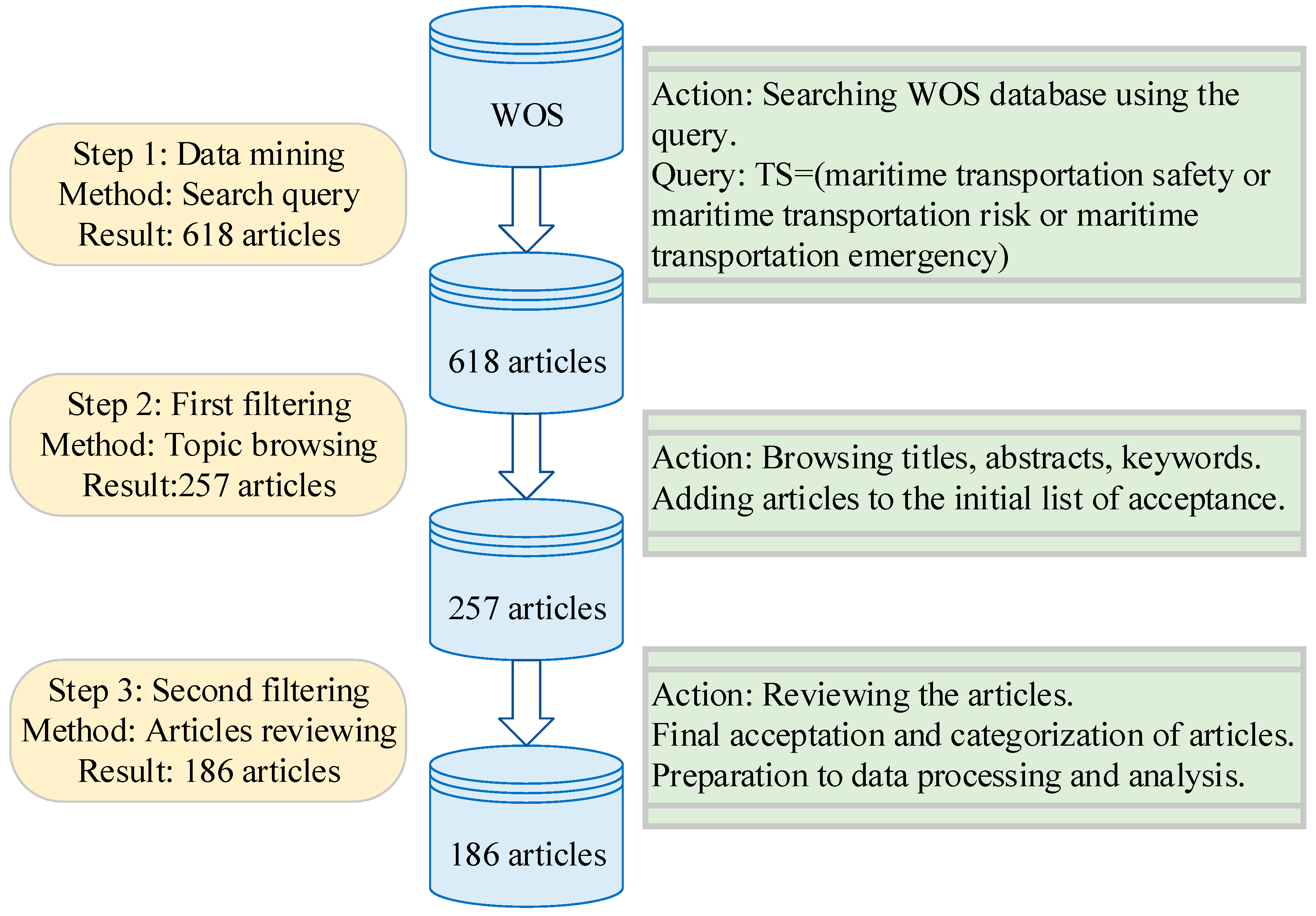
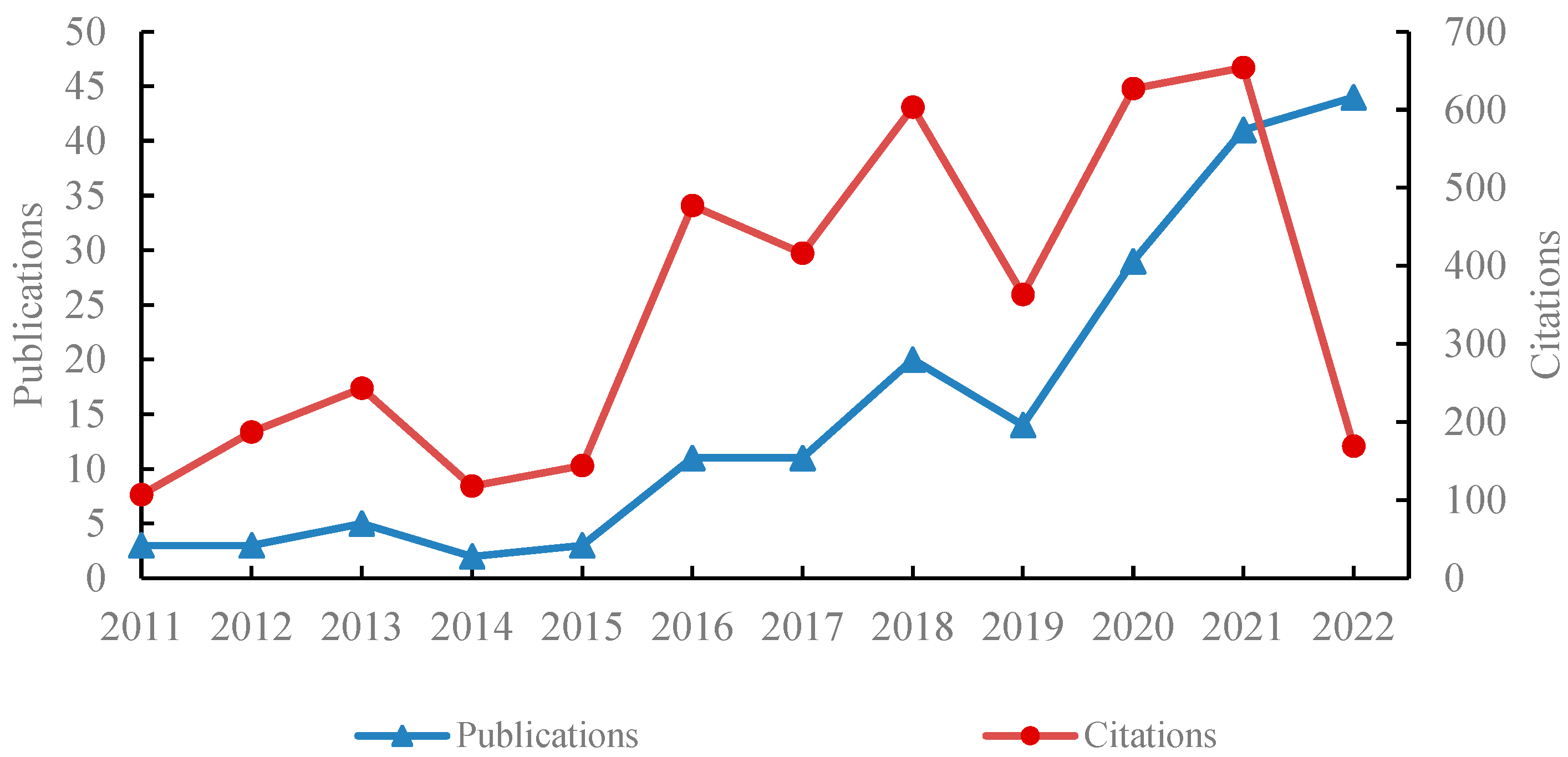



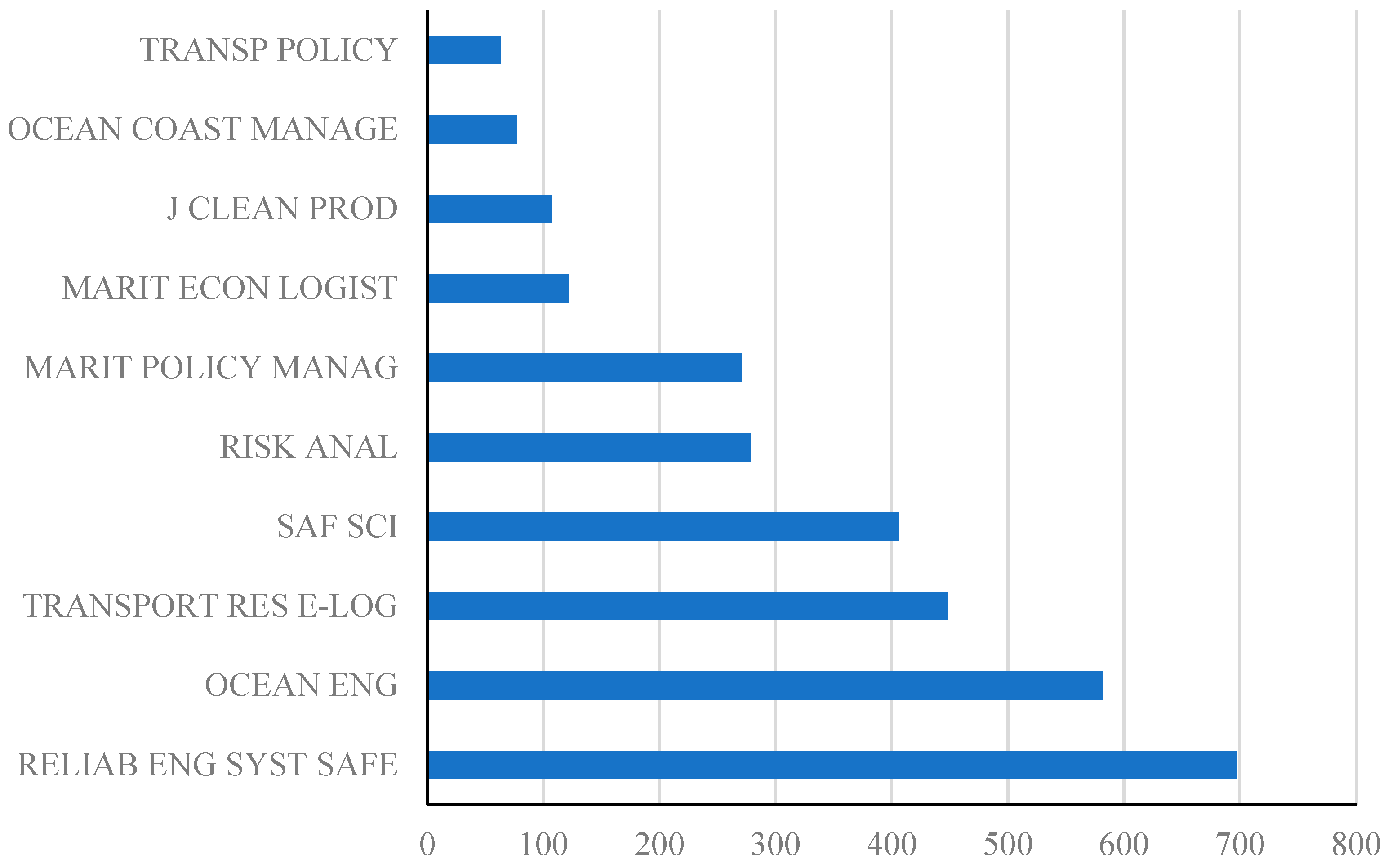
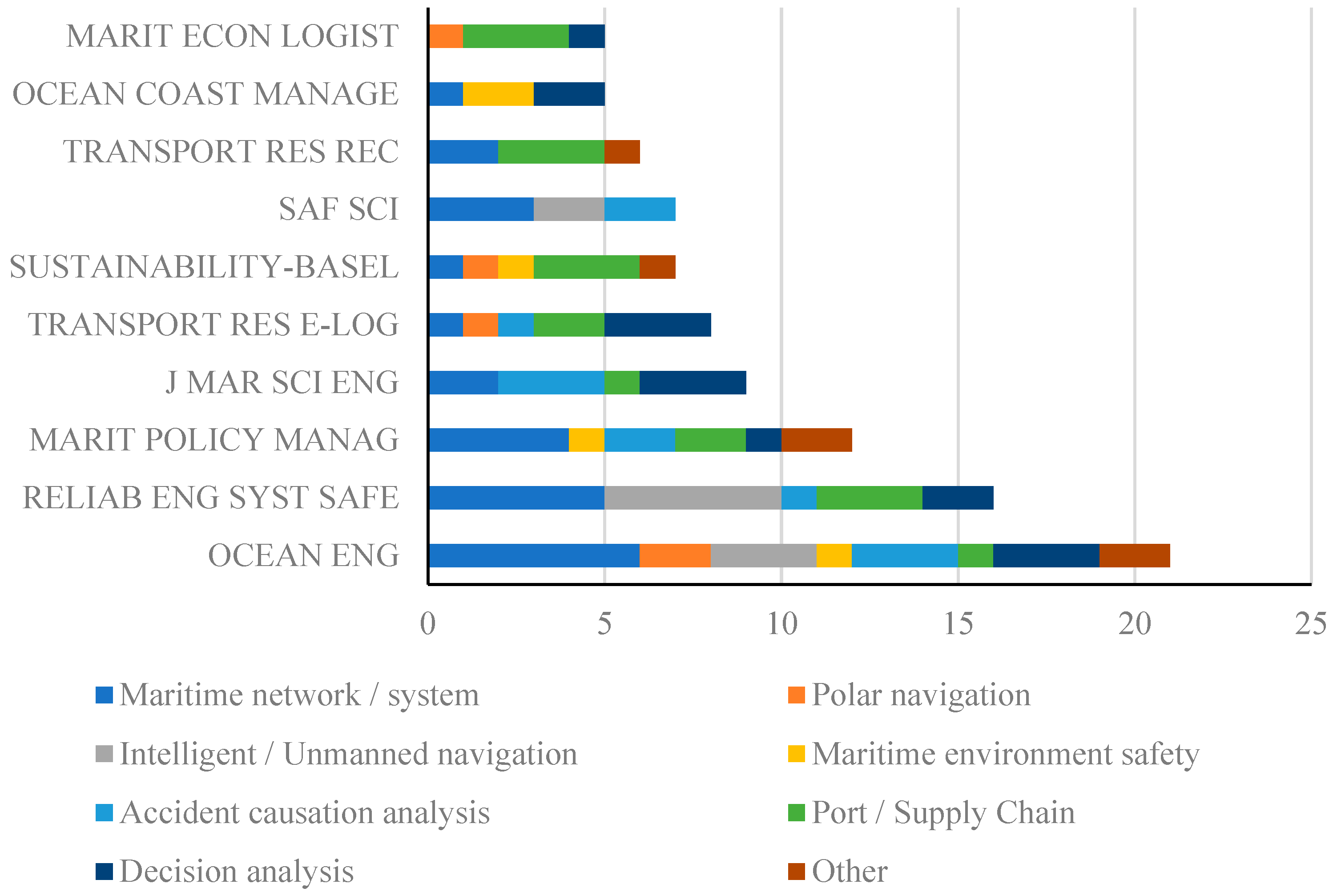


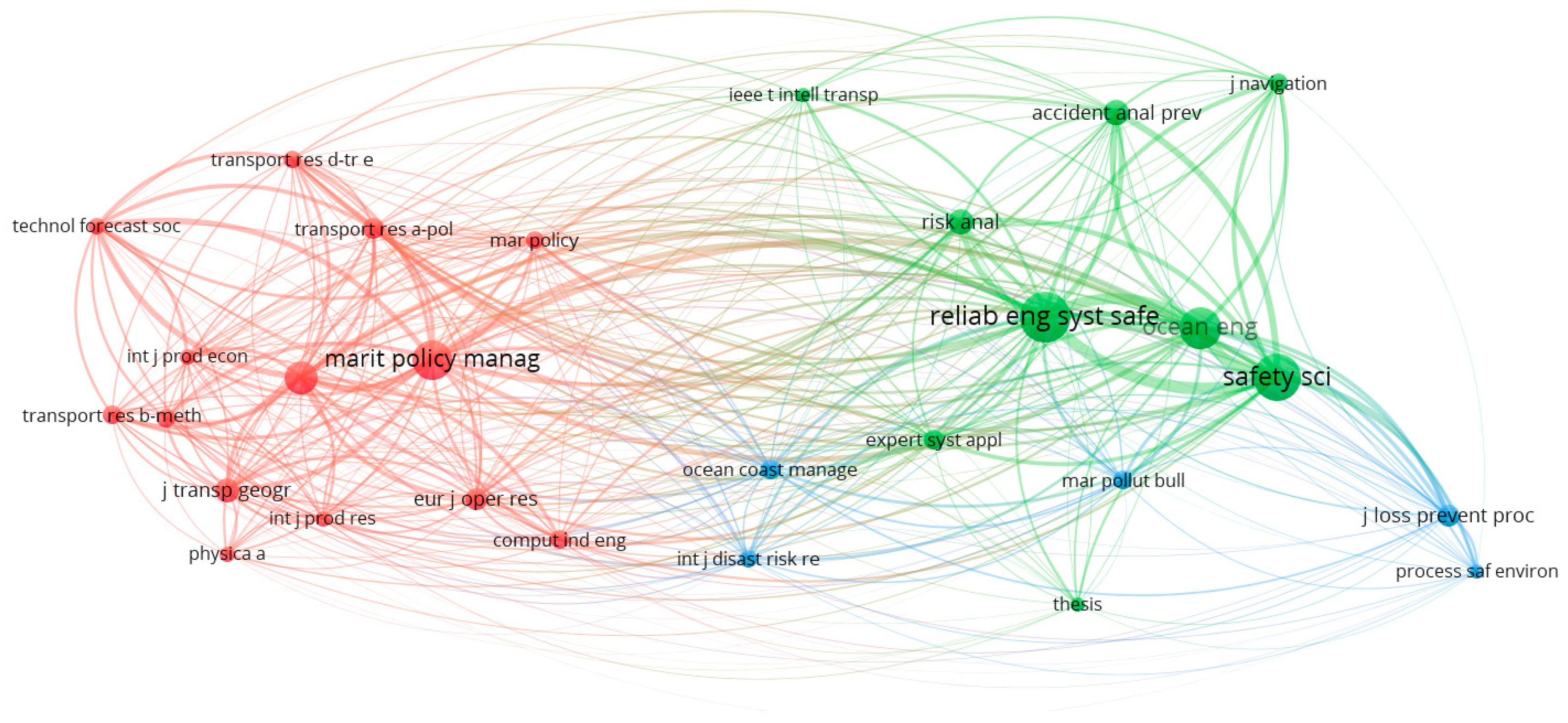


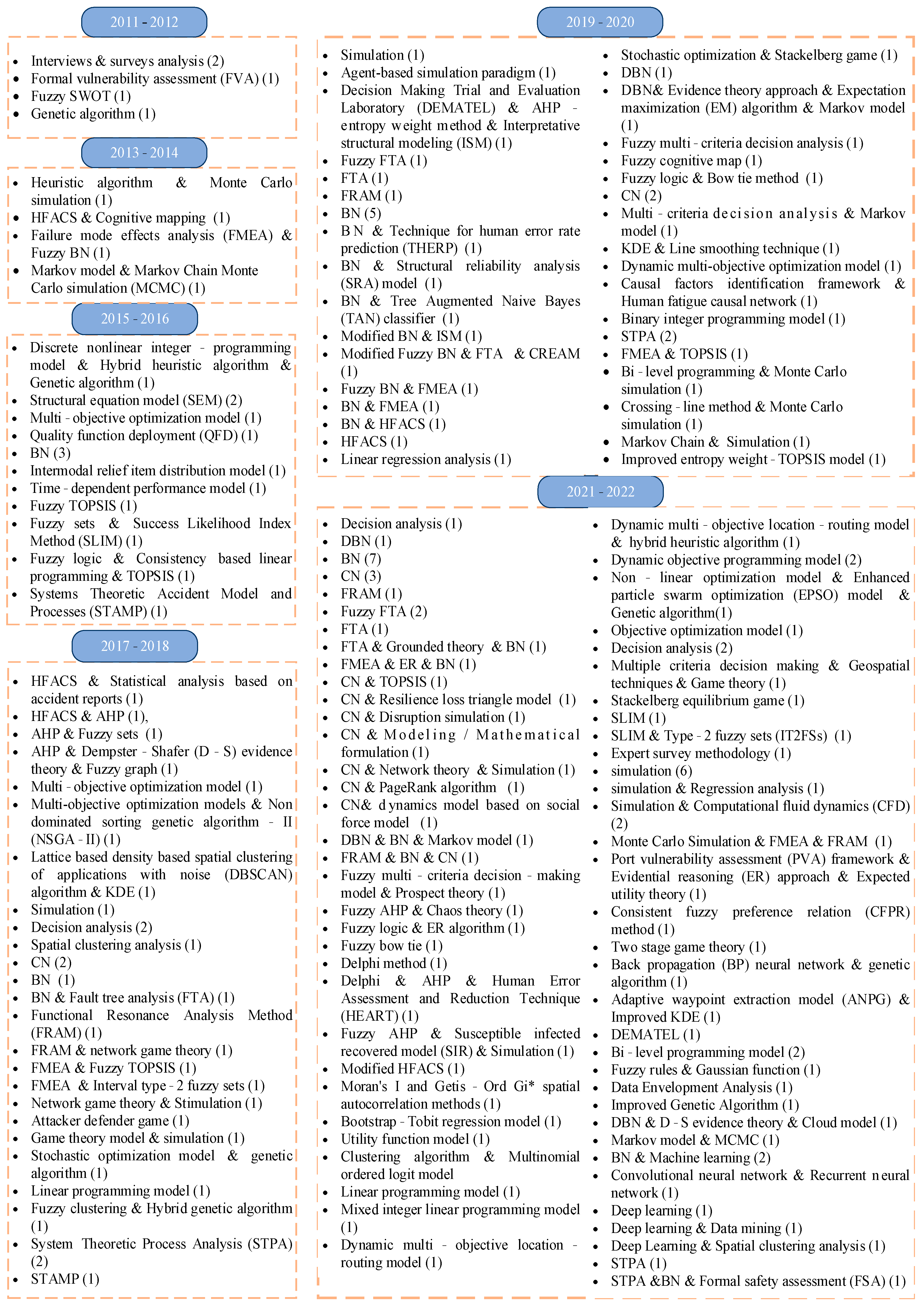
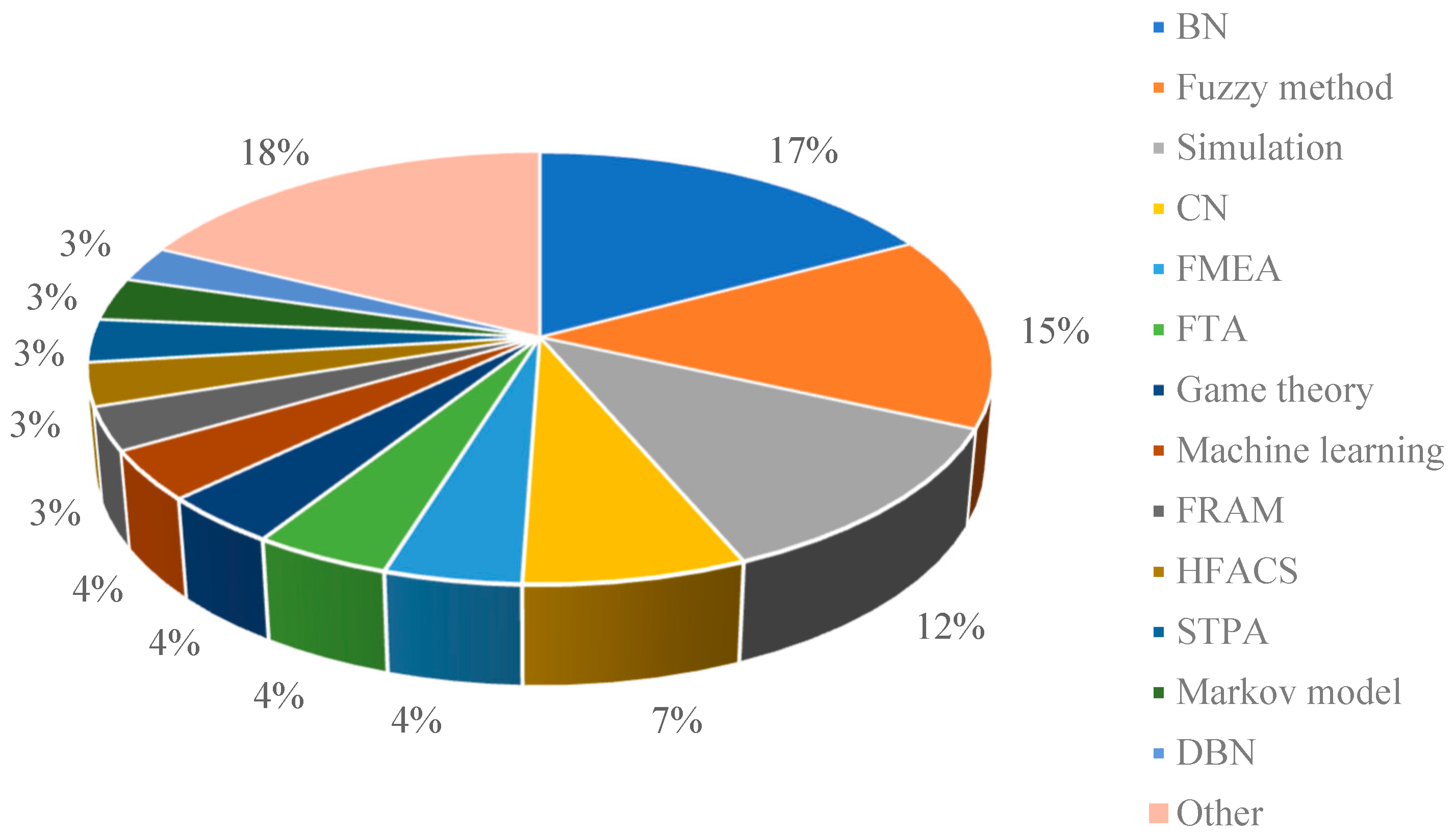

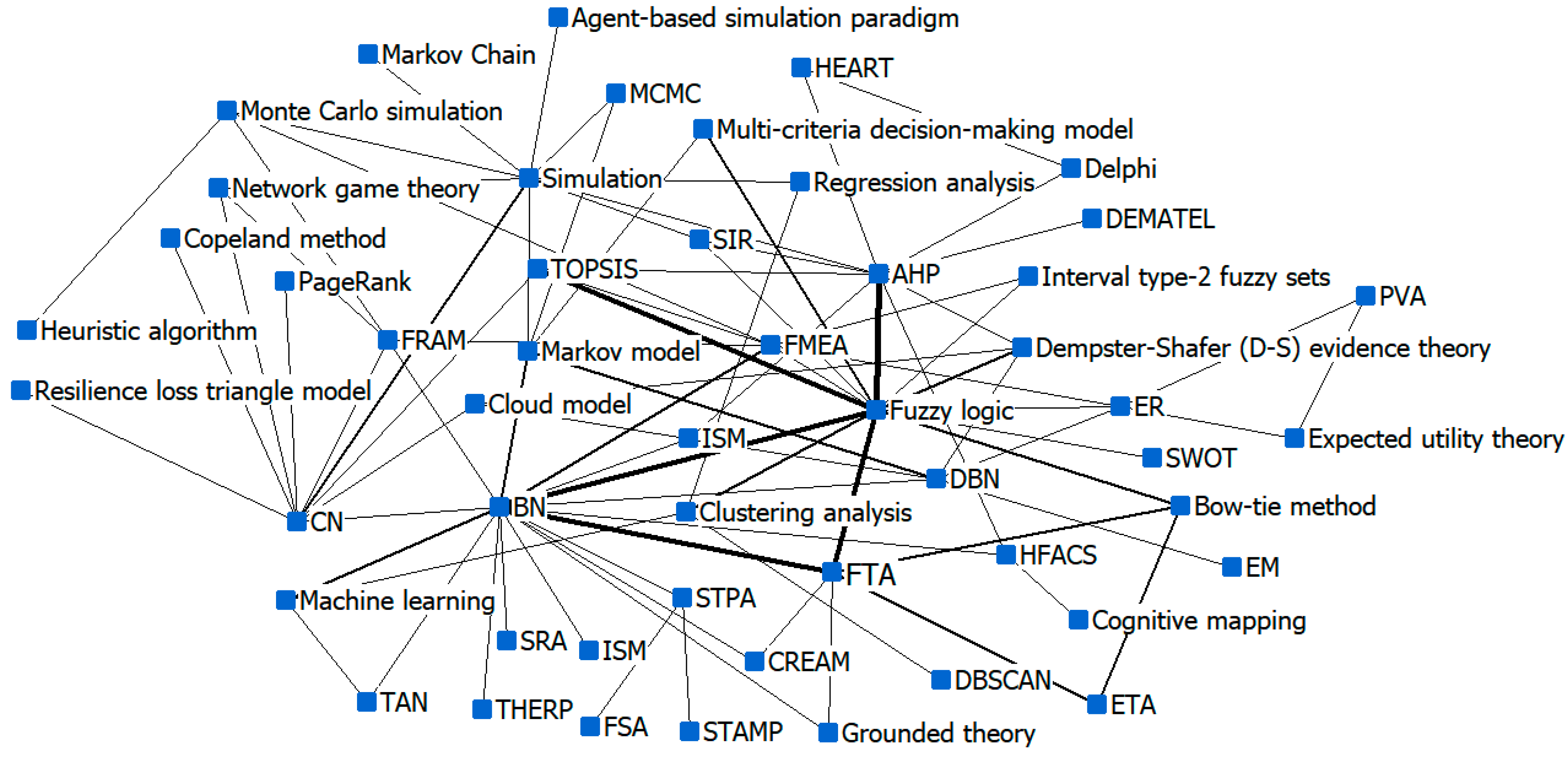
| Publication | Research Theme |
|---|---|
| [20] | Risk assessment models |
| [16] | Risk analysis |
| [11] | Risk analysis |
| [19] | Expert elicitation and BN modeling |
| [21] | Maritime transport policy |
| [10] | Fire and explosion accidents |
| [14] | Models and computational algorithms |
| [22] | Marine fuels |
| [23] | Navigation data visualization |
| [24] | Cyber risk perception |
| [18] | Human and organizational factors analysis |
| [15] | Human factors and safe performance |
| [25] | Resilience |
| [13] | Human reliability analysis |
| [12] | Risk assessment methods |
| Category | Description |
|---|---|
| Maritime network/system | Assessment of the resilience of maritime transportation networks; exploring the vulnerability of transportation networks; maritime transportation system risk assessment and safety analysis; designing maritime safety management systems. |
| Polar navigation | Decision making on process risk of Arctic route; optimizing the management for Arctic mass rescue events; interfering ship navigation process safety in Arctic waters. |
| Intelligent/unmanned navigation | Assessment of the potential impact of unmanned vessels; risk assessment of the operations of maritime autonomous ships. |
| Marine environment | Analyzing oil spill risk assessments; predicting the oil spill’s trajectory; studying optimal scheduling of emergency resources for maritime oil spills; causes of oil spill pollution; providing a scientific basis for targeted strategic oil spill emergency planning. |
| Accident causation analysis | Exploring the causal factors of marine accidents; evaluation of the prediction of marine accident consequences; human error assessment. |
| Port/supply chain | Improving the resilience strategies of ports/supply chain; managing port operational efficiency. |
| Decision analysis | Optimization of maritime emergency material allocation; studies on emergency evacuation management; improving emergency management operations. |
| Other | All other studies not specified above. |
| Article | Source | Total Citations | CY |
|---|---|---|---|
| An Overview of Maritime Waterway Quantitative Risk Assessment Models [20] | Risk Analysis | 158 | 14 |
| Towards the assessment of potential impact of unmanned vessels on maritime transportation safety [50] | Reliability Engineering & System Safety | 141 | 21 |
| A Human and Organisational Factors (HOFs) analysis method for marine casualties using HFACS-Maritime Accidents (HFACS-MA) [42] | Safety Science | 141 | 13 |
| Marine transportation risk assessment using Bayesian Network: Application to Arctic waters [51] | Ocean Engineering | 112 | 20 |
| Multi-objective decision support to enhance environmental sustainability in maritime shipping: A review and future directions [52] | Transportation Research Part E-logistics And Transportation Review | 111 | 13 |
| An advanced fuzzy Bayesian-based FMEA approach for assessing maritime supply chain risks [53] | Transportation Research Part E-logistics And Transportation Review | 105 | 23 |
| Disruptions and resilience in global container shipping and ports: the COVID-19 pandemic versus the 2008–2009 financial crisis [54] | Maritime Economics & Logistics | 102 | 39 |
| A quality function deployment approach to improve maritime supply chain resilience [55] | Transportation Research Part E-logistics And Transportation Review | 100 | 13 |
| Maritime Transportation Risk Assessment of Tianjin Port with Bayesian Belief Networks [56] | Risk Analysis | 99 | 13 |
| A marine accident analysing model to evaluate potential operational causes in cargo ships [57] | Safety Science | 81 | 12 |
| Keywords | Strength | Start | End | 2011 to 2022 |
|---|---|---|---|---|
| Accident | 3.0334 | 2016 | 2017 |  |
| Maritime transportation | 1.8375 | 2017 | 2018 |  |
| Transportation | 1.3173 | 2018 | 2019 |  |
| Optimization | 0.5586 | 2018 | 2019 |  |
| Disaster | 2.2001 | 2018 | 2019 |  |
| Network | 1.4665 | 2018 | 2019 |  |
| Vulnerability | 0.3527 | 2018 | 2019 |  |
| Emergency evacuation | 2.2001 | 2018 | 2019 |  |
| Port | 0.731 | 2019 | 2020 |  |
| Management | 1.3672 | 2019 | 2020 |  |
| Operation | 1.3958 | 2020 | 2021 |  |
| Maritime accident | 1.1139 | 2020 | 2021 |  |
| Risk | 1.4033 | 2020 | 2021 |  |
| BN | 3.1174 | 2020 | 2021 |  |
| Recovery | 1.1139 | 2020 | 2021 |  |
| Sustainability | 0.8203 | 2021 | 2022 |  |
| Maritime safety | 0.8203 | 2021 | 2022 |  |
| Methods | Quantitative | Interactivity | Interpretability | Decoupling | Memorable | Sequential | Scalability | Extendibility |
|---|---|---|---|---|---|---|---|---|
| BN [97] | ✓ | ✓ | ✓ | ✓ | ✓ | |||
| Fuzzy method [93] | ✓ | ✓ | ||||||
| Simulation [102] | ✓ | ✓ | ✓ | ✓ | ✓ | ✓ | ✓ | |
| CN [49] | ✓ | ✓ | ✓ | ✓ | ✓ | ✓ | ||
| FMEA [99] | ✓ | ✓ | ✓ | |||||
| FTA [93] | ✓ | ✓ | ✓ | ✓ | ||||
| Game theory [103] | ✓ | ✓ | ✓ | ✓ | ||||
| Machine learning [98] | ✓ | ✓ | ✓ | ✓ | ✓ | |||
| FRAM [89] | ✓ | ✓ | ✓ | ✓ | ||||
| HFACS [94] | ✓ | |||||||
| STPA [104] | ✓ | ✓ | ✓ | |||||
| Markov model [44] | ✓ | ✓ | ✓ | ✓ | ||||
| DBN [44] | ✓ | ✓ | ✓ | ✓ | ✓ |
Disclaimer/Publisher’s Note: The statements, opinions and data contained in all publications are solely those of the individual author(s) and contributor(s) and not of MDPI and/or the editor(s). MDPI and/or the editor(s) disclaim responsibility for any injury to people or property resulting from any ideas, methods, instructions or products referred to in the content. |
© 2023 by the authors. Licensee MDPI, Basel, Switzerland. This article is an open access article distributed under the terms and conditions of the Creative Commons Attribution (CC BY) license (https://creativecommons.org/licenses/by/4.0/).
Share and Cite
Xu, M.; Ma, X.; Zhao, Y.; Qiao, W. A Systematic Literature Review of Maritime Transportation Safety Management. J. Mar. Sci. Eng. 2023, 11, 2311. https://doi.org/10.3390/jmse11122311
Xu M, Ma X, Zhao Y, Qiao W. A Systematic Literature Review of Maritime Transportation Safety Management. Journal of Marine Science and Engineering. 2023; 11(12):2311. https://doi.org/10.3390/jmse11122311
Chicago/Turabian StyleXu, Minqiang, Xiaoxue Ma, Yulan Zhao, and Weiliang Qiao. 2023. "A Systematic Literature Review of Maritime Transportation Safety Management" Journal of Marine Science and Engineering 11, no. 12: 2311. https://doi.org/10.3390/jmse11122311
APA StyleXu, M., Ma, X., Zhao, Y., & Qiao, W. (2023). A Systematic Literature Review of Maritime Transportation Safety Management. Journal of Marine Science and Engineering, 11(12), 2311. https://doi.org/10.3390/jmse11122311






